
Kamui
-
Posts
25 -
Joined
-
Last visited
Posts posted by Kamui
-
-
When we are talking about the strategic and the tactical aspects of these tanks, still the outcome will be that on a strategic scale there would be no Victory possible.
If the point is like Germany should have produced cheaper tanks, then it's logic that their tactical superiority in Firepower and Armoring would be lost. If there are no advantages over the enemy tanks, then your only option is to produce more tanks then the enemy has. And that would have meant, that Germany would had to produce the same or higher number as USSR + USA + UK together. And that's absolutely impossible - even when you leave the fact away, that factories in USA or USSR didn't had to face a strategic bomber campain as Germanys industry did.
-
-> Der Alte Fritz
And for sure i have to disagree here. By 1942 the command of the Wehrmacht was taken totally out of hand from Generals and taken over by Hitler. His deceisive orders "Hold positions on all costs" displays a total loss of realism. Also Washington or London would never have agreed on a seperate peace, too many things were involved.
Take a look on Operation Bagration in 1944 -> http://en.wikipedia.org/wiki/Operation_Bagration
2,33 million Soldiers on Soviet side against 800,000 on German.
-
-> Dieseltaylor
Well the Panther had an minimum Side armor of 40mm and most armored surfaces are sloped.
I'm refering to my Encyclopedia http://www.angelfire.com/indie/kamuichan/

-
-> Dieseltaylor
About the Comets armoring, here is the data:
A34 Cruiser Tank Comet
Turret Front: 102mm@90°
Mantlet: 102mm@90°
Turret Sides: 64mm@90°
Turret Rear: 57mm@90°
Turret Top: 20mm@0°
Superstructure Front: 76mm@90°
Hull Front: 64mm@90°
Superstructure Sides: 29mm@90°
Hull Sides: 14mm@90°
Superstructure Rear: 25mm@90°
Hull Rear: 25mm@90°
Superstructure Top: 14mm@0°
Hull Bottom: 14mm@0°
The Side Hull armor could be easily penetrated by 20mm Automatic Guns or heavy AT Rifles. Anything from 37mm up had no trouble ripping through all of the Side or rear Armor.
As for the Front armor, i agree with you on it's thickness and realiabilty - the British similar as the Germans relied on rolled homogenous armoring for many of their tanks.
-
-> Vark
I think it does matter whether the tank that i produce last 5 Minutes in Combat or 5 weeks. One tank crew was around 5 men included weeks of training and experience. If tanks get shot down like flies not only the production materials but also the crews are wasted.
When you look at the situation in 1944-45 the Soviet Union put all efforts into tank production while civilians were starving in thousands. It's easy to keep up logistics and refill if tanks don't get older then just one week and if all the production goes into fuel and supplies. Oftenly the tanks rolled out fresh from factory to the front, just to get destroyed. With such a lifespan, it's no wonder that there have been rarely any problems with gears and onboard equipment. If the concept of disposable tanks and disposable crews are an operational/strategic success, then that assumption is right.
However, with the Introduction of the Main Battle Tank MBT design and current tanks have an liveage of over 30 years, it shows that other values are valid.
-> Der alte Fritz
I fully believe that Panther and Tiger have been the most suitable tank for a situation that never could have been won, no matter by whom. If you're facing an superiority of so many enemies, not only in tank but also in airplane production, you can't win. For the records it still should be noted kill ratio of Tigers and Panther were 1:5+
In Soviet Union 1941 - 1942 the Luftwaffe played a major part in destroying stronger enemy tanks, same as it was in France 1940 with Somua S35, Char B1 bis or Matilda Mk.II.
British and French Tank doctrine was mainly similar - they divided tanks into 2 classes: slow Infantry Tanks and fast Cavalry/Cruiser Tanks. When spotting the German tanks in France and Northern Africa, they soon proved to be inferior by certain aspects missing that the German tanks had (Mobility, Firepower, Armoring, Radio Communication, Gunsights, etc.). The British after the war used the Centurion which was firstly designated as "heavy Cruiser Tank", then became "Universal Tank" and finally Main Battle Tank
The American Tank Killer vehicles had been rather a quick solution by the General staff for battling German tanks. In practise they proved to be underprotected and vulnerable. This comes clear when you think that they haven't been used after WW2 anymore. Rather then that, the US relied on their newly designed vehicle models Pershing -> Patton and Chaffee.
In the USSR the concept of Cruiser and Infantry Tank was known as well, respectively in BT Cruiser Tank Series (BT-2, BT-5, BT-7) as well as T-18 & T-26 Infantry Tank Series. They were dropped in favor of medium T-34, heavy KV-1, JS-2 and light T-60, T-70 tanks.
This shows, that all major nations went on the same route as Germany did with it's Panther tank, except for fitting on still more armor.
-
The A34 Comet had Speed and an altered 17pdr Gun which gave it Firepower, but it clearly lacked armor (thin plates and also horizontal). For further details, check this site http://ww2armor.jexiste.fr/Files/Allies/Allies/1-Vehicles/UK/3-CruiserTanks/Comet/1-Genesis-Production.htm
-
> Vark
I can't judge shifting the gears now, as I don't have more detailed info on the subject. The thing though is, comparing the mentioned tanks directly with each other. Not 1 Panther vs 5 T-34 or 8 Shermans but 1 Panther vs 1 T-34 vs 1 M4 Sherman.
One have to think that one Panther weighted 45 tons, an T-34 weighted about 30 tons. So if you calculate for taking out 45 tons, the Soviet needed 150 - 240 tons?
Once more on the armor:
http://yarchive.net/mil/ww2_tank_armor.html
Certainly the US had the expertise and facilities to produce
cast AFV hulls and turrets. As another poster detailed, most of the
many M4s we produced had cast turrets, and a majority had cast
hulls. Castings, though, have certain inherent disadvantages. No
matter how metallurgically sophisticated a nation is, the physics
dictates that grain orientation cannot be controlled, and grain growth
is mostly uncontrollable, in large castings. Thus even the most
elegant tool steel alloys are not particularly strong as raw castings,
without work hardening to make a fine grain structure. Casting's main
advantages, once the tooling is built, are production rate and lower
(not higher!) technological requirements. A casting
facility--especially one that works with simple alloys--can be not
much more than a big building, an overhead crane and a furnace.
Rolled plate, on the other hand, may not be perfect, but it can offer
fairly good and consistent grain size, work hardening, and especially
grain orientation. Welding of fabricated plate sections, if done
properly, does not compromise these advantages. The gains from plate's
metallurgical advantages more than offset the small trigonometric
differences in effective thickness from small angles of incidence of
shell impact against angled sections of cast hulls and
turrets. Sophisticated heat treating can be combined with rolling to
make very strong steel. But good rolled plate requires a very, very
expensive and complicated mill. There are not many in the world. I
believe the reason the Russians did not make tanks of plate is that
they simply did not have the mill capability.
As for the soviet Shells, you can check on this site http://www.battlefield.ru/content/category/10/44/64/lang,en/ In all my researches i found only that Soviets didn't used Penetration caps for their rounds, but only ballistic caps.
Since these informations, the Panther is the best. And as I said before, neither the Soviet Union, nor the USA would have stand a chance in a similar condition if the enemy is producing 5 times more tanks. Whatever tank they had produced, it would be an operational failure if it's not made from paper, cost 1$ a piece and kills enemies from 5km.
-
Hmm, I can't agree with certain points on from begin with:
Mass Production. If you take a look on the stats in http://www.wwiivehicles.com/wwii/production.asp you'll notice that the USSR and USA outproduced Germany in tanks by far, additionally neither the US nor the USSR suffered under an strategic bombing campaign. Would the US be faced with a situation in competing against 1 against 3, it would be also on lost ground. Bearing in mind that the Kill Ratio of Tiger and Panther against allied tanks are 1:5 or more, things look very different.
Armoring: Next of, the armor quality of German and American/Soviet tanks differed quite a lot. While in German vehicles mostly face hardened or at least rolled homogenous armor were used, American or Soviet tanks used extensively cast armor for fastening the production. In combat cast armor proved to be inferior to RHA. Soviet Shells proved to be weak even against non sloped german armoring (i get into that in Firepower).
Mobility: The Panther was one of the best among mobility, faster then the Sherman in all aspects and on par with the T-34 on Road. As a comparism, here are the track widths of the 3 tanks (M4 Sherman: 420mm, T-34: 550mm, PzKpfW V Panther: 660mm)
Firepower: The 76,2mm F-34 gun of early T-34 showed the weakest penetration, plus it was hindered by it's ammunition which had no penetration cap. Therefore the face hardened plates of PzKpfw III & IV, same as of Tiger I oftenly shattered incoming soviet shells. The 85mm D-5T tank gun showed better performance, but still suffered under ammunition without penetration cap. The american shells APC M61 & APC M62 for 75mm and 76,2mm Guns oftenly malfunctioned, as the explosive filler went off during the process of penetrating the armor (especially on spaced armor as on PzKpfw III & IV). Since that the British removed the explosive filler from Sherman ammunition stocks they received. The 75mm KwK 42 of Panther along with its PzGr. 39/42 outclassed both Guns.
In that aspect the Panther is without a doubt the best of all 3, though in my opinion it would be like comparing an M1A1 Abrams or Leopard 2A6 with an T-72 or T-55. In combat situations though still I'd favour the Tiger over the Panther.
-
Hi there,
I would like to inform you about my WW2 Encyclopedia which is based on MS Excel and can be found at http://www.angelfire.com/indie/kamuichan/ If you don't have MS Excel, there is a link to an excel viewer around as well.
I covered most any Info i could find on free websites and in books, including Small Arms, Ammunition, Ballistic Tables, Artillery, Vehicles, Armored Vehicles, Tanks, Planes, Navy Vessels, etc.
Feel free to comment anytime.
-
Hi again rune,
no prob about that mate. I assume they dropped the APHE shells in favor of AP shots due to problems with fuzes and penetration had priority over destruction power. For me it stays mysterious, same as the non usage of penetration caps on japanese APHE shells.
-
Hi Rune,
for researches and gathering infos from websites, I always try to compare several of them for accordance. From what I read up to now, I got the idea that the british only used solid shots and had an HE shell for the 2pdr, which wasn't used in service. However, after your direction i checked again and found corresponding info:
The 2 pdr was originally armed with AP Shell (an armour piercing round with an explosive filler), the design of this round was asked for in September 1934 and provided by January 1936 - these rounds were filled with Lyddite. In 1938 it was decided to provided a projectile with better penetration performance, the first AP Shot was asked for in 1938. Interim steps involved inert filling of stocks of empty AP shell.
I also updated the info on my WW2 Excel Encyclopedia
http://www.angelfire.com/indie/kamuichan/
Thank, Kamui
-
It's been a time since I've last took a look into the Forum. But now, WOW! I could imagine some flaws in US fuzes, but didn't know it was that drastic!
It's ridiculous, for I remember in WW1 German naval ammunition proved more reliable then british rounds, therefore i thought they confiscated them and research primers and fuzes for copying.
-
I would like to make some additions here. I`ve been gathering historic data on WW2 now for some years and in my experience there are oftenly biased explanations favoring certain sides (russian, american, german) etc.
In example, when searching for penetration data on several websites you might oftenly find conflicting numbers or incorrect designations. These are partly from bad translations flaws in researching or propaganda.
Regarding soviet APBC & APBC/HE Shells
On website http://www.battlefield.ru/content/category/10/44/64/lang,en/ you can find similar information as in topic.

1.) An Armor-Piercing High Explosive projectile with a sharp nose (APHE);
2.) An Armor-Piercing High Explosive projectile with a blunt nose and a ballistic cap (APHEBC);
3.) A Solid Armor-Piercing projectile with a blunt nose and a ballistic cap (APBC);
4.) A Solid Armor-Piercing projectile with a blunt caped and a ballistic cap (APCBC).
The information on developer site about APBC statingArmour Piercing with Ballistic Cap (APBC). An AP projectile with a truncated nose (as if the end had been sawn off) covered by a light weight ballistic cap to improve flight characteristics. The truncated nose has better penetration above certain velocities, particularly when it overmatches the target armour plate and when the plate is prone to brittle failure. This was a common projectile for the USSR in World War Two as they did not use APC projectiles until the 1950s.
is definetely wrong. The USSR developed blunt nose projectiles which proved better against inclined armor then sharp tip shells, but they had no effect on german face hardened armor....This type of shell was specially designed to burst strong case-hardened and cemented armor. It destroyed the highly fragile case-hardened armor layer with its capped nose...For references see website http://www.freeweb.hu/gva/weapons/introduction.html#Face_Hardened_Armour
Regarding AP/HE projectiles or fillersFace hardening (FH) is a method used to increase the armour hardness of the surface of armour plate. The rear side of the armour plate remains at its original hardness. Face hardening is carried out by taking a slab of RHA and heat treating it again, but on one side only. The heat treating is time consuming and results in a warped plate which must then be flattened in large presses. The Germans were able to handle plates up to and including 50mm thickness (with production oversizes up to 55mm), and tried 80mm FH on the early Panther glacis. Later on the Germans found a way to use a heavy electrical current flow through the steel to induction-harden one face. Both methods were used until the end of the war.The purpose of the hardened face is to shatter an incoming projectile’s head before it can penetrate. The Germans found it resisted Soviet uncapped AP and APBC projectiles quite well, when the armour plate thickness was around the same size or not too badly overmatched by the projectile (such as Pz.Kpfw.IV 50mm front armour vs. Soviet 45mm or even 76mm AP or APBC). Britain and the USA tested projectiles against FH armour as a matter of course until about 1943, but rarely used it on production vehicles because of its relatively poor resistance to German APCBC in comparison to RHA. The Germans were faced with APC and APCBC from the Western allies only, not the Soviets, so their decision to use FH armour weakened their tanks against Western guns but strengthened them against Soviet guns.
Armor Piercing ammunition had been developed originally in late 19th century against armored ships. For such targets it was not enough to just make a hole here or there but also to cause internal damage. Same principle is for tanks which is called "after armor effect". A good example would be the german Mauser Tankgewehr in WW1, which was able to penetrate the armoring of british or french tanks but didn`t necessarily cause the vehicle to stop, so crews had been ordered to aim for the places where internal fuel tanks are located.
Nations as Russia, Germany, Italy and Japan used mostly AP/HE and other projectiles with filler to cause an explosion inside the target after the armor had been penetrated. Especially german ammunition had been successfull on that terms against M4 Sherman which was sometimes referred as "Ronson lighter" or "Tommy cooker".
Britain didn`t made use of AP/HE ammunition in WW2 for they believed this type of ammo would be unreliable and also has lower penetration abilities. The USA developed AP/HE ammunition for their 75mm and 76,2mm guns, however due to bad quality of their primers it oftenly lead to failure. When the british received lend lease shermans and 75mm guns, they removed the explosive fillers from american ammunition.
http://www.freeweb.hu/gva/weapons/britain.html#Explosive_Filler_in_Armour_Piercing_Projectiles
No British AP or APCBC projectiles had an explosive filler in the warhead. Even when the British used USA projectiles for the 75mm gun, such as the M61, they removed the HE filler. In the Churchill Service Instruction Book, it is described as M61 Shot, with the diagram showing that the fuse found in the USA projectile was replaced by a plug holding only the tracer.The words “shot” and “shell” have two distinct meanings in English and are often used loosely which can result in some confusion. “Shot” is a contraction of roundshot and harks back to the early days of artillery; it implies a solid projectile with no internal cavity. “Shell” on the other hand is used to describe a projectile with an internal cavity, which may be used to contain HE, smoke, shrapnel, etc.
-
Daimler Armored Car Mks.I - II
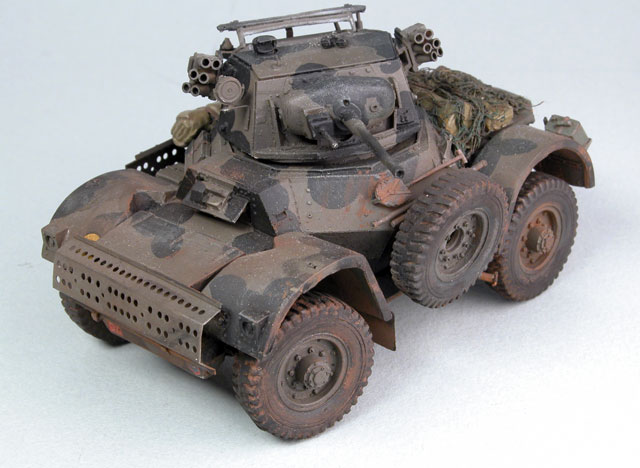
Country: UK
Manufacturer: Daimler Co.
Introduced: April 1941
Produced Qty: overall 2964
Crew: 3 men
Length: 3,96 m
Width: 2,43 m
Height: 2,25 m
Engine: Daimler 6Cyl.
Power: 71 kw
Fuel Type: Gasoline
Weight: 7,50 t
Power/weight ratio: 9,47 kw/t
Max Speed: 80 km/h
Max Range: 322 km
Suspension: 4x4 wheeled
Armoring as listed below...
Turret mantlet: 16@90
Turret front: 16@???
Turret sides: 16@???
Turret rear: 14@???
Turret top: 8@90
Hull front upper: 14@???
Hull front lower: 14@???
Hull sides upper: 10@???
Hull sides lower: 10@???
Hull rear upper: 14@???
Hull rear lower: 14@???
Hull top: 8@90
Hull bottom: 7@90
Armament as below...
see version info
Variants:
Mk.I: Original model
1x 2pdr OQF Mk.IX L/50 (55 Rounds)
1x 7,92mm MG Besa Mk.I (2000 Rounds)
Mk.I CS: Close Suppor Version with howitzer
1x 3.00'' OQF Mk.I L/26 (25 Rounds)
1x 7,92mm MG Besa Mk.I (2000 Rounds)
Mk.II: Last version with improved turret, modified gun mount, better radiator, driver escape hatch.
1x 2pdr OQF Mk.IX L/50 (55 Rounds)
1x 7,92mm MG Besa Mk.I (2000 Rounds)
Comments: Developed from the Dingo Scout Car and fitted with the turret of light Tetrarch tank, it proved to be an effective scout vehicle and stayed in service with the british military till 60s.
-
Humber Armored Car Mks.I - IV

Country: UK
Manufacturer: Humber Co.
Introduced: 1940
Produced Qty: overall 4500
Crew: 3-4 men (depending on version)
Length: 4,57 m
Width: 2,19 m
Height: 2,16 m
Engine: Rootes 6Cyl.
Power: 67 kw
Fuel Type: Gasoline
Weight: 7,10 t
Power/weight ratio: 9,44 kw/t
Max Speed: 72 km/h
Max Range: 402 km
Suspension: 4x4 wheeled
Armoring as listed below...
Turret mantlet: 15@90
Turret front: 15@???
Turret sides: 10@???
Turret rear: 10@???
Turret top: 6@90
Hull front upper: 15@???
Hull front lower: 15@???
Hull sides upper: 10@???
Hull sides lower: 10@???
Hull rear upper: 10@???
Hull rear lower: 10@???
Hull top: 6@90
Hull bottom: 6@90
Armament as below...
see version info
Variants:
Mk.I: Original version, based on the Guy Armoured Car body.
1x 15mm MG Besa Mk.I (100 Rounds)
1x 7,92mm MG Besa Mk.I (2000 Rounds)
Mk.II: Changes to the turret, better armour around driver and radiator.
1x 15mm MG Besa Mk.I (100 Rounds)
1x 7,92mm MG Besa Mk.I (2000 Rounds)
Mk.III: Larger three-man turret with provisions for a wireless operator freeing up the wireless operation tasks of the commander.
1x 15mm MG Besa Mk.I (100 Rounds)
1x 7,92mm MG Besa Mk.I (2000 Rounds)
Mk.IV: Equipped with the US M5 or M6 37 mm high velocity gun in place of the 15 mm BESA. The larger gun required the removal of the third crewman in the turret (the wireless operator). Turret hatches were rearranged with the new gun and crew layout.
1x 37mm Gun M6 L/57 (51 Rounds)
1x 7,92mm MG Besa Mk.I (2000 Rounds)
Comments: The Humber AC was an successfully developement out of the previous Guy AC and it stayed in service untill the end of war.
-
Guy Armored Car Mks.I & IA

Country: UK
Manufacturer: Guy Motor Co.
Introduced: 1939
Produced Qty: overall 101
Crew: 3 men
Length: 4,12 m
Width: 2,06 m
Height: 2,29 m
Engine: Meadows 4ELA
Power: 41 kw
Fuel Type: Gasoline
Weight: 5,20 t
Power/weight ratio: 7,88 kw/t
Max Speed: 64 km/h
Max Range: 340 km
Suspension: 4x4 wheeled
Armoring as listed below...
Turret mantlet: 15@90
Turret front: 15@???
Turret sides: 10@???
Turret rear: 10@???
Turret top: 6@90
Hull front upper: 15@???
Hull front lower: 15@???
Hull sides upper: 10@???
Hull sides lower: 10@???
Hull rear upper: 10@???
Hull rear lower: 10@???
Hull top: 6@90
Hull bottom: 6@90
Armament as below...
see version info
Variants:
Mk.I: Original model 50 buil.
1x 0.50'' MG Vickers Mk.V (500 Rounds)
1x 0.303'' MG Vickers Mk.VII (1000 Rounds)
Mk.II: Second model with improved armament.
1x 15mm MG Besa Mk.I (100 Rounds)
1x 7,92mm MG Besa Mk.I (1000 Rounds)
Comments: This was the first british Armored Car in modern shape and lead to a series of furtherly improved models. They saw combat in France and went obsolete in 1943.
-
Morris CS9 Light Armored Car
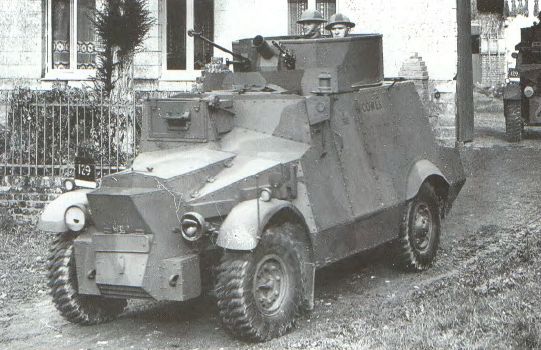
Country: UK
Manufacturer: Morris Co.
Introduced: 1938
Produced Qty: overall 99
Crew: 4 men
Length: 4,77 m
Width: 2,05 m
Height: 2,13 m
Engine: Morris 6Cyl.
Power: 72 kw
Fuel Type: Gasoline
Weight: 4,50 t
Power/weight ratio: 16,00 kw/t
Max Speed: 73 km/h
Max Range: 385 km
Suspension: 4x2 wheeled
Armoring as listed below...
Turret mantlet: none
Turret front: 7@???
Turret sides: 7@???
Turret rear: 7@???
Turret top: open
Hull front upper: 7@???
Hull front lower: 7@???
Hull sides upper: 7@???
Hull sides lower: 7@???
Hull rear upper: 7@???
Hull rear lower: 7@???
Hull top: ???
Hull bottom: ???
Armament as below...
1x 0.55'' Boys Mk.I (30 Rounds)
1x 0.303'' MG MG Bren Mk.I (1000 Rounds)
Comments: This AC was based on a Morris Truck chassis and served in the battle of France as well as in northern Africa. It retired soon from combat as it`s armament and armoring were still pre-war standards.
-
Lanchester 6x4 Armored Car Mks.I - II

Country: UK
Manufacturer: Lanchester Motor Co.
Introduced: 1930
Produced Qty: overall 35
Crew: 4 men
Length: 4,87 m
Width: 1,93 m
Height: 2,82 m
Engine: Lanchester 6Cyl.
Power: 66 kw
Fuel Type: Gasoline
Weight: 4,88 t
Power/weight ratio: 13,53 kw/t
Max Speed: 75 km/h
Max Range: 290 km
Suspension: 6x4 wheeled
Armoring as listed below...
Turret mantlet: none
Turret front: 9@???
Turret sides: 9@???
Turret rear: 9@???
Turret top: ???
Hull front upper: 9@???
Hull front lower: 9@???
Hull sides upper: 9@???
Hull sides lower: 9@???
Hull rear upper: 9@???
Hull rear lower: 9@???
Hull top: ???
Hull bottom: ???
Armament as below...
1x 0.50'' MG Vickers Mk.V (500 Rounds)
1x 0.303'' MG MG Vickers Mk.VII (2000 Rounds)
Variants:
Mk.I: Original Version with dual rear tires.
Mk.II: Single tires, turret cupola with sloped sides.
Comments: Another pre war design which bears some resemblance to Rolls Royce armored car. They have been mostly used in far east, Singapore and Malaya.
-
Rolls Royce Armored Car 1924 Pattern Mk.I

Country: UK
Manufacturer: Rolls Royce Co.
Introduced: 1924
Produced Qty: overall 150
Crew: 4 men
Length: 5,18 m
Width: 1,90 m
Height: 2,33 m
Engine: Rolls Royce 6Cyl.
Power: 37 kw
Fuel Type: Gasoline
Weight: 3,86 t
Power/weight ratio: 9,59 kw/t
Max Speed: 75 km/h
Max Range: 240 km
Suspension: 6x4 wheeled
Armoring as listed below...
Turret mantlet: none
Turret front: 9@???
Turret sides: 9@???
Turret rear: 9@???
Turret top: ???
Hull front upper: 9@???
Hull front lower: 9@???
Hull sides upper: 9@???
Hull sides lower: 9@???
Hull rear upper: 9@???
Hull rear lower: 9@???
Hull top: ???
Hull bottom: ???
Armament as below...
1x 0.55'' Boys Mk.I (30 Rounds)
1x 0.303'' MG MG Vickers Mk.VII (1000 Rounds)
Comments: This armored car in it`s basic formed server allready in WW1, however in 20s to 30s the vehicles have been modernized and received some improvements and were still in use around outbreak of WW2 in western desert. They were withdrawn from the battlefield finaly in 1941.
[ December 01, 2007, 05:11 AM: Message edited by: Kamui ]
-
Morris Light Reconnaissance Car Mks.I - II
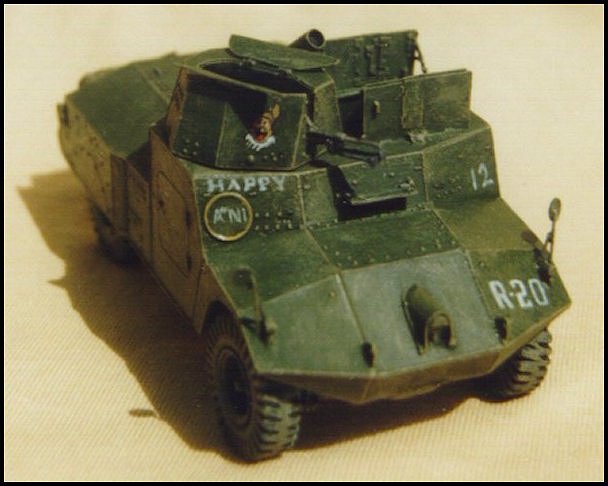
Country: UK
Manufacturer: Morris Co.
Introduced: 1940
Produced Qty: overall unknown
Crew: 3 men
Length: 4,06 m
Width: 2,03 m
Height: 1,88 m
Engine: Morris 4Cyl.
Power: 54 kw
Fuel Type: Gasoline
Weight: 3,70 t
Power/weight ratio: 14,59 kw/t
Max Speed: 80 km/h
Max Range: 385 km
Suspension: 4x2 & 4x4 wheeled
Armoring as listed below...
Turret mantlet: none
Turret front: 8@???
Turret sides: 8@???
Turret rear: 8@???
Turret top: 8@90
Hull front upper: 14@???
Hull front lower: 14@???
Hull sides upper: 8@???
Hull sides lower: 8@???
Hull rear upper: 8@???
Hull rear lower: 8@???
Hull top: 6@90
Hull bottom: 6@90
Armament as below...
1x 0.55'' Boys Mk.I (30 Rounds)
1x 0.303'' MG Bren Mk.I (1000 Rounds)
Variants:
Mk.I: Original model
Mk.II: New 4x4 chassis
Comments: This unusual looking car had an 3men crew sitting side by side. Not realy sure but i guess it must have been quite cramped. Used in Africa, Italy and northern europe.
-
Humber Light Reconnaissance Car Mks.I - III

Country: UK
Manufacturer: Humber Co.
Introduced: 1940
Produced Qty: overall 3100
Crew: 3 men
Length: 4,37 m
Width: 1,88 m
Height: 2,08 m
Engine: Rootes 6Cyl.
Power: 65 kw
Fuel Type: Gasoline
Weight: 2,80 t
Power/weight ratio: 23,21 kw/t
Max Speed: 72 km/h
Max Range: 180 km
Suspension: 4x2 & 4x4 wheeled
Armoring as listed below...
Turret mantlet: none
Turret front: 7@???
Turret sides: 7@???
Turret rear: 7@???
Turret top: 7@90
Hull front upper: 14@???
Hull front lower: 14@???
Hull sides upper: 7@???
Hull sides lower: 7@???
Hull rear upper: 7@???
Hull rear lower: 7@???
Hull top: 6@90
Hull bottom: 6@90
Armament as below...
see version info
Variants:
Mk.I: Original model with open topped hull.
2x 0.303'' MG Bren Mk.I (2000 Rounds)
Mk.II: Second model received roof armour and machine gun turret.
2x 0.303'' MG Bren Mk.I (2000 Rounds)
Mk.III: New four-by-four chassis. Externally similar to the Mk II.
1x 0.55'' Boys Mk.I (30 Rounds)
1x 0.303'' MG Bren Mk.I (1000 Rounds)
Comments: This vehicle is close to Humber scout car and most likely uses the same engine. It was the first light scout car to feature also limited antitank capabilities with installed Boys ATR
[ November 29, 2007, 12:11 PM: Message edited by: Kamui ]
-
Humber Scout Car Mks.I - II
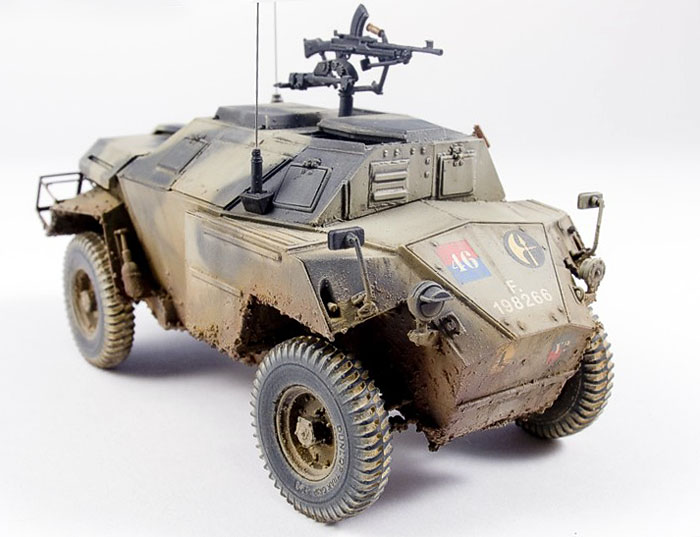
Country: UK
Manufacturer: Humber Co.
Introduced: 1942
Produced Qty: overall n.a.
Crew: 3 men
Length: 3,83 m
Width: 1,87 m
Height: 2,13 m
Engine: Rootes 6Cyl.
Power: 65 kw
Fuel Type: Gasoline
Weight: 3,40 t
Power/weight ratio: 19,12 kw/t
Max Speed: 100 km/h
Max Range: 320 km
Suspension: 4x4 wheeled
Armoring as listed below...
Turret mantlet: turretless
Turret front: turretless
Turret sides: turretless
Turret rear: turretless
Turret top: turretless
Hull front upper: 14@???
Hull front lower: 14@???
Hull sides upper: unknown
Hull sides lower: unknown
Hull rear upper: unknown
Hull rear lower: unknown
Hull top: open
Hull bottom: unknown
Armament as below...
1x 0.303'' MG Bren Mk.I
Variants:
Mk.I: Original model
Mk.II: Improved transmission
Comments: A light british scout car with good cross country performance i think. The armament consisted of one Bren machinegun above the roof with an 100 rounds drum. The gun itself was attached to a special mounting and could be operated from inside the vehicle.
[ December 04, 2007, 12:46 PM: Message edited by: Kamui ]
-
Daimler Scout Car Mks.I-III "Dingo"
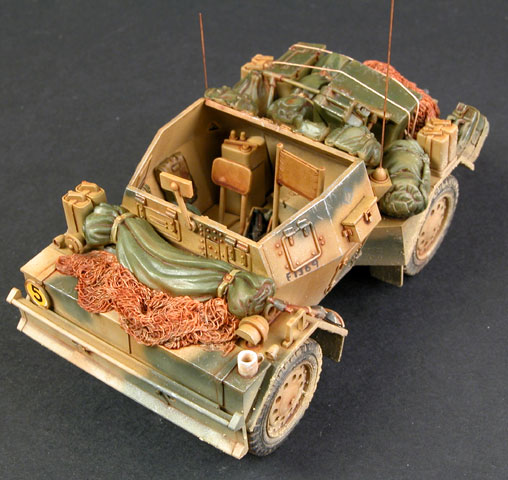
Country: UK
Manufacturer: Daimler Co.
Introduced: 1939
Produced Qty: overall 6626
Crew: 2 men
Length: 3,18 m
Width: 1,71 m
Height: 1,50 m
Engine: Daimler 6Cyl.
Power: 41 kw
Fuel Type: Gasoline
Weight: 4,50 t
Power/weight ratio: 9,11 kw/t
Max Speed: 88 km/h
Max Range: 322 km
Suspension: 4x4 wheeled
Armoring as listed below...
Turret mantlet: turretless
Turret front: turretless
Turret sides: turretless
Turret rear: turretless
Turret top: turretless
Hull front upper: 30@???
Hull front lower: 30@???
Hull sides upper: unknown
Hull sides lower: unknown
Hull rear upper: unknown
Hull rear lower: unknown
Hull top: open
Hull bottom: unknown
Armament as below...
1x 0.303'' MG Bren Mk.I (1000 Rounds)
Variants:
Mk.I: original model with four-wheel steering and sliding roof.
Mk.II: second model, featured front-wheel steering.
Mk.III: last model, changes included waterproofed engine and no roof.
Comments: The Dingo was an small but well armored car (30mm in front) for it`s size. It featured a crew of 2 men and had an small place to fit an Bren Machinegun. Though there was no roof armor protection for the crew it was popular among it`s crews and successfull throughout the war.
-
This is my first thread on Battlefront Forums, i hope it`s OK to post in TOW modding forum as i`m very fond of that game and soon want to see many more units here

I`m working on an WW2 encyclopedia since some years by now and recently updated with new data. As with Combat Mission and TOW there is first time an chance of realistic combat simulations i`d like to contribute to modding community by posting infos on all kinds of AFV, Planes, Ships, Handweapons and whatever else equipment used in WW2. If you`re interested in something special, please let me know, i will try to write about it then.
Now i`d like to start with Armored Cars of WW2 anyways, as i`ve reworked that section quite recently.
Panzerwagen Steyr ADGZ
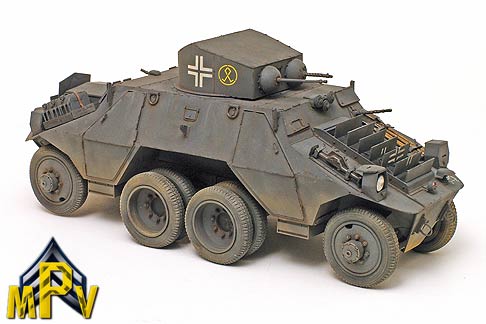
Country: Austria
Manufacturer: Austro Daimler PW
Introduced: 1935
Produced Qty: 27
Crew: 6 men
Length: 6,26 m
Width: 2,16 m
Height: 2,56 m
Engine: Austro Daimler 6Cyl.
Power: 112 kw
Fuel Type: Gasoline
Weight: 12,00 t
Power/weight ratio: 9,33 kw/t
Max Speed: 70 km/h
Max Range: 225 km
Suspension: 12x8 wheeled
Armoring as listed below...
Turret mantlet: none
Turret front: 11@???
Turret sides: 11@???
Turret rear: 11@???
Turret top: 11@90
Hull front upper: 11@???
Hull front lower: 11@???
Hull sides upper: 11@???
Hull sides lower: 11@???
Hull rear upper: 11@???
Hull rear lower: 11@???
Hull top: 6@90
Hull bottom: 6@90
Armament as below...
1x 20mm KwK36 L/45 (100 Rounds)
2x 7,92mm MG34 (3000 Rounds)
Comments:
This armored car has been constructed and built by austrian company Steyr and turned out to be quite complicated. It was taken over by Germany after "Anschluss" and used in duty by SS or Police forces against partisans.

Panther, T-34 or Sherman - best design of the war?
in Combat Mission: Barbarossa to Berlin
Posted
From what we have learned from history, the best means to fight a tank is another and better tank, fullstop.
Why is that?
1.) German experiences in WW2. When the Wehrmacht spottet the french B1 Bis or the british Matilda Mk.II everything except lucky shots proved to be senseless. The only solution were the 88mm FlaK Guns transported on Halftracks or in stationary models, alternatively the Ju-87 Stuka. The same happened on the eastern front. A single soviet KV-1 halted an entire Platoon for several hours. Latewar German models achieved an kill ratio of 1:5 - 1:8 as allready mentioned.
2.) Anti Tank Guns and Tank Killer vehicles proved to be vulnerable to Machine Gun Fire, Grenades, Mortar Shells or small Infantry Arms. They quickly disappeared after WW2 again. Nowadays you have APCs carrying AT Missiles as T.O.W. or MILAN, which are meant to be fired from a great distance
3.) Assault Guns offered armored protection, but poor vision and poor mobility. Against enemy Infantry they were at loss, especially with the usage of HEAT Rockets or Hollow Charges. They disappeared after WW2 same as the arms mentioned above.
4.) Later wars showed exactly the same problems that the Germans faced on the eastern front. In the Korean war, north Korean forces rushed down almost to Pusan - regardless of how many cheap produced counter weapons the present US Forces could wield -> http://www.youtube.com/watch?v=wNUebgSYq5U&feature=related Only after reinforcements from Japan and other countries arrived, which equaled the numbers to the north Koreans, they could gain back lost territory. It's up to you, to imagine how things would look if the americans would have used Tigers or Panthers there.
5.) During cold war and with the developement of the main battle tank in 1970s, most all countries followed the idea to create an high quality tank with superior performance. The idea of cheap production models was finally put to the grave. If you need a proof for this, just take a look at Leopard 2A6, M1A2 Abrams, Challenger 2 or T-90